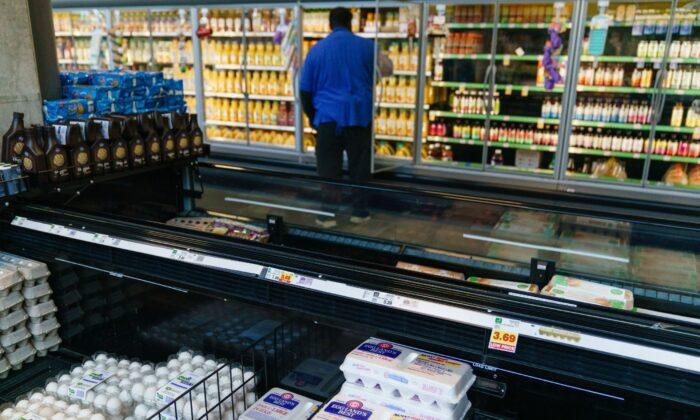The core inflation rate, which excludes the volatile energy and food sectors, slowed to 5.6 percent year-over-year last month, down from 5.7 percent. This was also higher than the market estimate of 5.5 percent.
On a month-over-month basis, the Consumer Price Index (CPI) rose by 0.5 percent, and the core CPI increased by 0.4 percent.
Nearly all the indexes jumped on a monthly basis, with food prices rising by 0.5 percent and energy costs surging by 2 percent. The food and energy indexes were 10.1 percent and 8.7 percent higher, respectively, than they were at the same time a year ago.
Grocery store prices were still up by 11.3 percent year-over-year, with eggs soaring by 70.1 percent, lettuce surging by 17.2 percent, and bread jumping by 14.9 percent. Margarine costs spiked by 44.7 percent, butter rose by 26.3 percent, coffee advanced by 12.9 percent, and baby food rose by 10 percent.
On the energy front, gasoline prices rose by 2.4 percent month-over-month, and they remain up by 1.4 percent year-over-year. Energy services climbed at an annualized pace of 15.6 percent, including an 11.9 percent boost in electricity costs and a 26.7 percent increase in utility piped gas services.
Shelter continued to climb, increasing by 7.9 percent in the 12 months ending in January. Rents increased by 8 percent.
From December 2022 to January, new vehicles edged up by 0.2 percent, used cars and trucks fell by 1.9 percent, apparel swelled by 0.8 percent, and medical care commodities rose by 1.1 percent. Transportation services tacked on 0.9 percent, while medical care services dropped by 0.7 percent.
This was the first CPI report to be calculated by the BLS’s new methodology.
In December 2022, the federal agency announced that it would update weights annually based on a single calendar year of consumption data from 2021 rather than two years of expenditure statistics. This is a critical change because spending was weighed significantly more toward goods consumption than services, where inflation is now elevated.
The January inflation data were a “perfect spoiler for Valentine’s Day,” according to Jan Szilagyi, CEO and co-founder of Toggle AI, an investment research firm.
“Markets were expecting (hoping, praying) to get further confirmation that a) peak is in and b) decline is at least steady, if not accelerating. This is critical for the disinflationary narrative and any hope for fed cuts this year,” he wrote. “We got neither.”
The U.S. financial markets struggled for direction following the release of the CPI report in pre-market trading, with the benchmark indexes flat.
The U.S. Dollar Index, which gauges the greenback against a basket of currencies, tanked on the data, plummeting by about 0.7 percent to roughly 102.60.
Has the Disinflation Process Begun?
Goods price growth has slowed for the past six months, driven by easing consumer demand and improving supply-chain conditions. Consumers have also shifted their consumption toward services.“Early signs of demand recovery for categories such as autos and furniture could reverse the downward trend in goods inflation, threatening to slow the Fed’s progress against inflation.”
“A hard-landing scenario would be deflationary,” he said in a note. “If growth persists, inflation will likely firm, too.”
In the fourth quarter, the U.S. gross domestic product (GDP) growth rate came in at a better-than-expected pace of 2.9 percent. According to the Atlanta Fed Bank’s GDPNow model, first-quarter GDP is estimated to rise by 2.2 percent.
“The January survey meanwhile brought mixed messages on inflation,” said Chris Williamson, chief business economist at S&P Global Market Intelligence. “While costs were boosted in part by rising wage pressures, reflecting the tight labor market, tough competition once again limited scope to pass on these higher costs to customers in the form of higher prices.”
Last week, Fed Chair Jerome Powell told the Economic Club of Washington, D.C. that “the disinflationary process” and “the process of getting inflation down” has started.
The central bank chief noted that easing inflation had been seen in the goods sector, representing about one-quarter of the U.S. economy. However, services sector inflation continues to be heightened, rising to 7.6 percent in January, which could force the Federal Reserve to maintain its series of rate hikes.
“The reality is we’re going to react to the data, so if we continue to get, for example, strong labor-market reports or higher inflation reports, it may well be the case that we have to do more and raise rates more than is priced in,” he said.
But Gene Inger, a former financial television analyst and author of “The Inger Letter,” noted that the U.S. central bank could “fade the pace of hikes and realize they’ve belatedly of course done almost all they can ’really' do.”
“The market should digest that well,” he wrote in a note.





